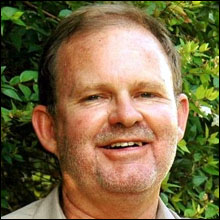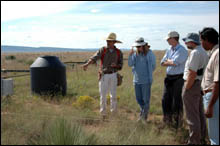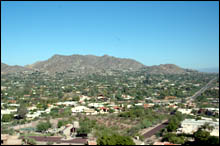SAEON gears up for 2007
|
- Johan Pauw
As we tackle 2007 with gusto and great expectations, it is time to reflect on the past year and to focus on what lies ahead for us in the coming year.
For SAEON, 2006 was dominated by the staging of the first SAEON Summit - the biennial roundup of all SAEON's stakeholders. Other highlights followed, such as the appointment of Professor Tim O'Connor as SAEON's Observation Science Specialist; the development of a demonstration model of the geo-spatial portal for SAEON data; the production of the biennial SAEON Overview; the hosting of the ILTER (International Long-Term Environmental Research) and ELTOSA (Environmental Long-Term Observatories of southern Africa) meetings in Namibia; the LTER study tour of the USA; the launch and workshops of the Graduate Student Network; the start-up of the SAEON Elwandle Node with Dr Angus Paterson as its captain; the signing of Accession Agreements with MINTEK and the CSIR's Natural Resources and Environment; the inclusion of the SADCO (South African Data Centre for Oceanography) contract management in the SAEON portfolio; consultative meetings with the Grassland Society of Southern Africa and the Arid Zone Ecology Forum; and several Education Outreach achievements and innovations.
SAEON Advisory Board and Technical Steering Committee
2006 was also the year in which the term of office of the members of the SAEON Advisory Board and the Technical Steering Committee came to an end. Whilst the process to appoint new members is ongoing, it is important to recognise the crucial role that these two bodies have played in the first three years of SAEON's existence by laying solid foundations and providing direction. The SAEON National Office, on behalf of the NRF (National Research Foundation), was fortunate to have been the recipient of sound advice whilst pioneering the development of the Network.
The Technical Steering Committee held rather intense workshops and produced founding documents such as the 'Design of SAEON', which informed the development process of the Network. Steering Committee members also served on Task Teams mandated to advise the National Office on the hosting arrangements of the different nodes.
At its last meeting, the Technical Steering Committee converged on the notion that SAEON requires more focused small group meetings rather than all-inclusive large meetings, as the Network's development has progressed to the stage where detailed discussions among specialists will be more productive than higher-order discussions by a broadly representative group. The approach of using smaller focus groups has already been introduced in Education Outreach where a national advisory group - the Network of Education Experts - has become fully functional.
SAEON's Data Management workshops with specialists in ICT and environmental observation will be held more regularly in the future as the central IT system of SAEON becomes operational. Meetings that centre on scientific topics will be coordinated by the Observation Science Specialist and attended by selected experts in the relevant disciplines.
The SAEON structure allows for a Node Liaison Committee to be formed for each node which will focus on the activities of the particular node.
Evolutionary development is taking place within SAEON, but the need for high-level coordinating meetings of the Advisory Board and the Technical Steering Committee will remain, although less frequent.
USLTER Study Tour
Four SAEON staff members (Tim O'Connor, Angus Paterson, Avinash Chuntharpursat and I) attended the triennial All Scientists Meeting: Contributions to Understanding Ecological Change of the USLTER last year. This presented an excellent opportunity to arrange a study tour to four LTER sites to gain a deeper understanding of the USLTER system and the current status of its science and information management, and get first-hand exposure to the manner in which their network is implemented. We gratefully acknowledge part sponsorship from the USLTER programme as well as in-kind contributions by the site managers.
The four sites visited were Jornada Experimental Basin, Sevilleta Experimental Range, Florida Coastal Everglades and Central-Arizona-Phoenix Urban LTER. These sites represent an excellent cross section of climatic regimes, inland versus coastal, and conservation versus urban systems. The USLTER is obviously very well resourced and the tour group was often exposed to high-tech experiments, such as a range of automatic sensors and wireless data transmission, complete with remote controlled webcams.
Organisationally, the USLTER sites still seem to function largely independent of each other. Hence it is only now, after 25 years of its existence, that concerted efforts are being made to synthesize across sites and develop a shared information management system. The LTER sites also appear to have limited influence on policy making, which is a direct result of the National Science Foundation's emphasis on 'basic' research.
Although there is much to learn from individual experiments and research projects, the tour group felt that SAEON's approach to coordinating its network of nodes holds many advantages over the competitive approach which has been followed in the USA, especially in view of the limited financial and human resources. These advantages for SAEON include the potential for synthesis, collaboration, efficiency, scientific progress and science-policy linkages.
SAEON Nodes: A brief status report
- SAEON Ndlovu Node (Savanna region) - managed and hosted by South African National Parks at Phalaborwa. Manager's position, vacant since August 2006, was filled on 1 January 2007. Current support staff: Data/GIS Manager and Education Outreach Officer. Agreement signed and official launch function held in September 2004.
- SAEON Elwandle Node (Coastal-Inshore region) - managed and hosted by SAIAB (South African Institute for Aquatic Biodiversity) in Grahamstown. Node Manager Dr Angus Paterson is presently appointing support staff. Agreement signed in November 2005. The official launch function must still be held.
- SAEON Node for Marine-Offshore Systems - managed by SAEON National Office and hosted by Marine and Coastal Management in Cape Town. Agreement signed in July 2006. Manager's position has been offered to the preferred candidate. The official launch function must still be held.
- SAEON Fynbos Node - to be managed and hosted by SANBI (South African National Biodiversity Institute) in Cape Town. The agreement has just been signed by the CEOs of SANBI and the NRF. The recruitment process for a Node Manager started in January and subsequently SAEON and SANBI will jointly plan and stage a launch function for the Node.
- SAEON Node for Grasslands, Forests and Wetlands - to be hosted in Pietermaritzburg. Negotiations on location details are underway and it is expected that the agreement will be drafted early in 2007.
- SAEON Node for Arid Lands - four potential node hosts have been identified and selection will take place early in 2007.
Outlook for 2007
2007 will see the final roll-out of SAEON's six nodes. It will also be a year in which suitable projects to deliver initial SAEON products will be identified and initiated under Tim O'Connor's leadership. Node managers will focus on establishing their stakeholder and organisational networks, as well as on the conceptual scientific design of the individual nodes. It is anticipated that the SAEON geo-spatial portal and data management system will become operational in 2007.
Education Outreach is set to grow and expand into the new nodes, and will feature prominently at the World Environmental Education Congress to be held in Durban later this year. It is also the year in which the first hands-on environmental monitoring projects should find implementation at schools in the Phalaborwa area via the SAEON Ndlovu Node.
|
|





